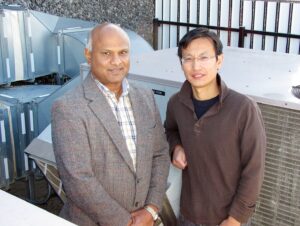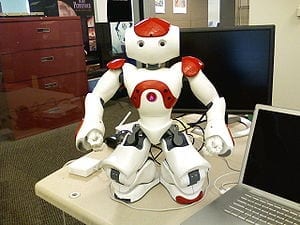
If widely adopted, the energy savings would be like taking 700,000 cars off the road every year
New super-efficient rooftop units that heat and cool commercial buildings offer significant energy and dollar savings, say scientists at the Department of Energy’s Pacific Northwest National Laboratory. They found that the devices reduce energy costs an average of about 41 percent compared to units in operation today.
The newly published report analyzes the operation of the commercial rooftop HVAC unit known as the Daikin Rebel, which was one of two units to meet DOE’s Rooftop Challenge, a competition for manufacturers to create a rooftop unit that significantly exceeds existing DOE manufacturing standards. Daikin Applied was the first to produce such a unit, which was studied in depth by PNNL researchers; Carrier Corp. also met the challenge. The work is part of a broader DOE program known as the DOE Rooftop Campaign, which promotes the adoption of efficient rooftop units.
The PNNL study, done by scientists Srinivas Katipamula and Weimin Wang, is an in-depth look at the performance of the Rebel compared to other rooftop units in use today. The devices are usually nestled on building roofs, far from view but crucial to our comfort. The devices demand a significant proportion of the 18 quadrillion BTUs of energy that the nation’s commercial buildings swallow every year.
The PNNL team estimates that if current rooftop units were replaced with devices similar to the Rebel over a 10-year period, the benefits in terms of energy saved and reduced pollution would be about equal to taking 700,000 cars off the road each year. Put another way, the reduced energy draw could idle about eight average-size coal-fired power plants in each of those 10 years.
If all rooftop units with a cooling capacity of 10 to 20 tons were replaced immediately, DOE officials estimate the cost savings at around $1 billion annually.
“There are great gains waiting to be made in energy savings, using technologies that exist today,” said Katipamula, whose study was supported by DOE’s Office of Energy Efficiency and Renewable Energy.
Katipamula and Wang ran extensive simulations analyzing the Rebel’s performance compared to other rooftop units. The pair used DOE’s Energy Plus building energy simulation software and worked with detailed performance data supplied by Intertek of Cortland, N.Y., which tested the units in the laboratory. Katipamula and Wang also created several new computer models — a necessary step because they were testing technology that has never existed before. The Rebel includes variable-speed fans and a variable-speed compressor, which allow it to respond more precisely to conditions inside a building than conventional technology.
The team ran simulations for a typical 75,000-square-foot big-box store in three cities: Chicago, Houston, and Los Angeles. They compared performance of the Rebel to three types of units: those in use today, those that meet current federal regulations for new units, and those that meet more stringent requirements, known as ASHRAE 90.1-2010 standards. DOE designed the Rooftop Challenge to exceed the ASHRAE standards.
The team found that the Rebel reduced energy costs and use as follows:
Go deeper with Bing News on:
Rooftop Challenge
- He visited Italy for the first time and bought a house within 24 hours
Los Angeles-based TV producer Paul Millet fell in love with the village of Latronico immediately and snapped up a $13,000 house on day one.
- CT greenhouse gas emissions up as climate change bills languish
As climate change bills struggle to get through the current legislative session, a new report shows Connecticut transportation emissions have increased sharply since 2020.
- Take the Abermination mountain bike challenge!
Take a ride along a five-mile loop of pristine, wooded single track on the Mississippi River bluffs! Friends of Off-Road Cycling (FORC) invites you to take the challenge of the Illiniwek Abermination ...
- 14 Best Non-Comedogenic Sunscreens for Even the Most Acne-Prone Peeps
On the flip side, if you have oily or acne-prone skin, you’re better off selecting mattifying or ultra-lightweight sunscreens that don’t leave you feeling like a grease pool midday. The Starface Clear ...
- Best Taylor Swift albums: We rated and ranked them all. Why our top pick really is 'The 1'
“Blank Space” was a huge hit and the album’s most compelling track, an electro-pop anthem with state-of-the-art production and a brilliant performance from Swift, who navigates the lyrics with ...
Go deeper with Google Headlines on:
Rooftop Challenge
[google_news title=”” keyword=”Rooftop Challenge” num_posts=”5″ blurb_length=”0″ show_thumb=”left”]
Go deeper with Bing News on:
Super-efficient rooftop units
- ‘We are energy nerds’
Call them the home energy nerds. It’s a niche for now, but baked into the nerd experience are lessons for everyone, and for utilities. The relationship between utility and customer is usually a ...
- Should California's Supreme Court overturn new rooftop solar rules?
California's Supreme Court has agreed to weigh in on controversial new rules that slash the financial incentive for people who install rooftop solar on their homes. The high court has agreed to hear ...
- Q1 2024 Carlisle Companies Inc Earnings Call
In his 2016 letter to Berkshire Hathaway shareholders, legendary investor Warren Buffett wrote, “Every decade or so, dark clouds will fill the economic skies, and they will briefly rain gold. When ...
- What's the Best Motorcycle Helmet You Can Buy? We Asked the Experts
We checked in with Revzilla's Pat McHugh for pro tips on what to look for in a motorcycle helmet. Here are some picks for the absolute best helmet you can buy.
- The aviation fuel/lead exposure connection
The findings are sure to intensify a fierce debate over the continued use of leaded aviation fuels at airports. Federal officials are working to phase out the use of lead in aviation fuel, known as ...
Go deeper with Google Headlines on:
Super-efficient rooftop units
[google_news title=”” keyword=”Super-efficient rooftop units” num_posts=”5″ blurb_length=”0″ show_thumb=”left”]










